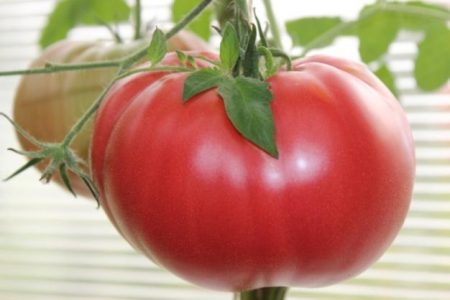 Tall tomato "Big Pink McClintock" is an ideal variety whose fruits have excellent taste and excellent yield. One of the best large-fruited varieties of recent times.
Tall tomato "Big Pink McClintock" is an ideal variety whose fruits have excellent taste and excellent yield. One of the best large-fruited varieties of recent times.
Content
Grade characteristics
“Big Pink McClintock” (McClintock’s Big Pink) arrived in Russia from the USA. The production of seeds in our country was established by the company "Russian Garden", thanks to which in just a few years a very large number of domestic gardeners learned about this variety.
Tomato is classified as a group of varieties with medium ripening. The vegetative period of plants lasts an average of 115-125 days. Tall bushes in a greenhouse reach two meters, in open ground their growth is less intense and amounts to 130-150 centimeters. Up to 5 flower branches form on the central trunk. The bush is overgrown with a voluminous green mass of "potato" large leaves.
Three to six large tomatoes form on each brush. Fruits are rounded, slightly flattened, with a slight ribbing at the peduncle. The skin is dense, elastic. In the stage of technical ripeness, the surface is painted dark green. And at the moment of biological maturity, the tomato is poured with bright red shades. There is a lot of pulp in tomatoes. Its structure is slightly sugar, with a small juice content. Big Pink McClintock tomatoes have an amazing juicy sweet taste and a pleasant tomato aroma. Taste features are perfectly balanced: there is both sweetness and sourness. Tomatoes keep their shape well in slices, but it cannot be said that they are dry. On the contrary, they have a lot of juice, which allows you to use these tomatoes in various preparations - from juices to pastes. The pulp also has a lot of seeds. The weight of the fruit is 300-500 grams.
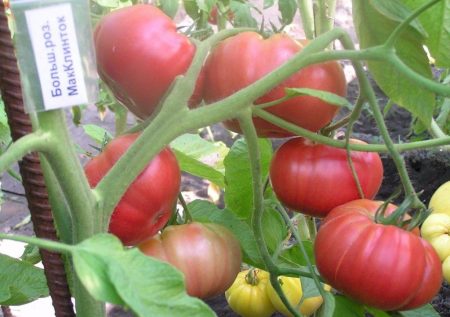
Grade Advantages:
- large-fruited;
- good yield;
- very tasty fleshy fruits;
- tomatoes have a universal purpose;
- dense peel allows tomatoes to be stored for a long time;
- immunity to many diseases;
- long fruiting period;
- tolerates short-term drought.
Among the large number of advantages, this variety has practically no shortcomings. Difficulties are brought only by a garter of bushes and frequent pinching. However, all the chores will be crowned with a good harvest.
Characterizing the variety “Big Pink McClintock”, one cannot fail to note its good productivity. When growing greenhouse from one bush, you can collect up to 4 kilograms of tomato, while in open ground this figure is significantly lower. Fruiting is also influenced by external factors, especially a lack of light and low temperatures.
The first fruits appear in mid-July. The bushes bear fruit sprawling, gradually giving the gardener large poured fruits. The last tomatoes are removed from the bushes with the onset of the first cold snap.
Features of growing tomato
Seeds are sown for seedlings in mid-March, so that planted bushes are planted in the greenhouse in the second decade of May. By this time, the seedlings will grow by 30-35 - centimeter tall and may already have one flower brush.
Before hitting seeds undergo preliminary training. Initially, they are soaked in a weak solution of manganese in order to disinfect.
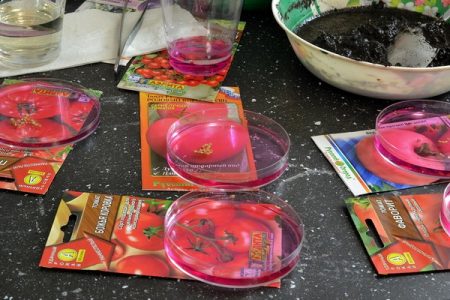
If the seeds are old or small, then you can treat them with a growth stimulator, which will provide better seedlings. You can plant seeds already germinated.To do this, the seed material is placed in a humid environment (wrapped in a cloth) and kept a couple of days next to the battery. So they quickly hatch and acquire white roots. In this form, produce a reserve of seeds in the ground.
Land for seedlings should be light, drained, nutritious. For this, the soil mixture is prepared from peat (which makes the soil loose), garden soil (which contains beneficial microorganisms) and humus (organic fertilizer for the rapid growth of shoots). The earth is scattered over seedlings, moisten well. Seeds are laid out on the surface of the soil, slightly recessed to a centimeter depth. The distance between the seeds is 2 centimeters. The row spacing is 4 centimeters. From above, the crops are covered with a centimeter layer of earth and again carefully watered.
To ensure rapid seedlings, the containers with crops are covered with transparent material and exposed to a bright place. The first shoots will appear in 5-8 days.
Conditions for sprouting seedlings:
- Air temperature - + 23-25 degrees.
- Humidity - 60%.
- Lighting - at least 14 hours a day.
At the stage of the appearance of the first pair of true leaflets (not cotyledons), seedlings need to be dived, since it can no longer grow in the total capacity.
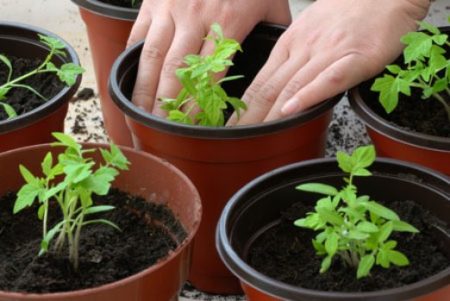
Individual seedlings are selected for seedlings, in which fresh soil is packaged, which also consists of the same components as during sowing. The pick should be carried out very carefully so as not to harm the weak roots. In the first days after transplanting, the seedlings are "sick", so it should be kept in partial shade. Then the tomatoes are put on the windowsill, supplying them with a constant influx of fresh (not cold) air, regularly watering and feeding with complex mineral fertilizers.
Landing
Mature seedlings are planted in fertile land. To do this, when planting beds, the soil is supplied with organic matter and minerals, well watered, disinfected from harmful microflora. Seedlings are planted in separately prepared wells. Overgrown specimens are pitted horizontally. Ordinary seedlings are placed perpendicular to the surface of the earth.
Tomatoes are planted with a small depth, so that more additional roots are formed. Immediately after planting, a peg is installed next to each bush, to which the first garter is carried out a couple of weeks later.
Tomato Care
Tomato "Big pink McClintock" is highly productive only growing in a warm environment. Therefore, it is mainly grown in a greenhouse than in open areas. In general, the variety is not picky in care. The main thing is to maintain a balance of temperature and humidity, to ensure that plants are comfortable growing.
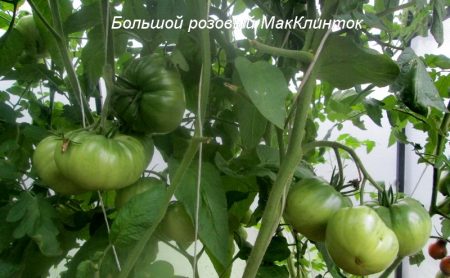
Comfort and environmental factors
In order for the plants to feel “at home” in the beds and to give a successful harvest, they need to be provided with good lighting. The more light that gets on the tomato bushes, the more juice the tomatoes will pour. Therefore, tomatoes should be placed in the greenhouse competently, giving them the brightest, most cozy place.
Tall tomatoes value privacy. And it must be a lot. Therefore, there should not be other beds and especially other tomatoes nearby. No more than two plants are placed on one square meter - this will provide them with optimally uniform lighting, good ventilation, and plentiful nutrition.
An important point when growing tomatoes in a greenhouse is to control the optimum temperature and humidity. Yes, plants like a warm-humid climate, but if it is too hot in the greenhouse and a swamp appears on the ground, the tomatoes will immediately react to all the discomfort. Dissatisfaction with the falling ovaries (at high air temperatures), the occurrence of fungal diseases (with high humidity) will be manifested.To prevent such incidents, you need to regularly carry out airing. And on hot days, keep the greenhouse open. Streams of fresh air will cool the heated atmosphere of the greenhouse, dry moisture on the surface of the earth.
The earth in the greenhouse, unfortunately, quickly compacts due to high humidity. As a result, moisture and air begin to penetrate poorly into the soil. Plant roots receive less and less nutrition. To correct the situation will help loosening, which is carried out after each irrigation procedure. Shaking the soil stimulates its rapid enrichment with oxygen. The roots of tomato bushes instantly receive a portion of oxygen.
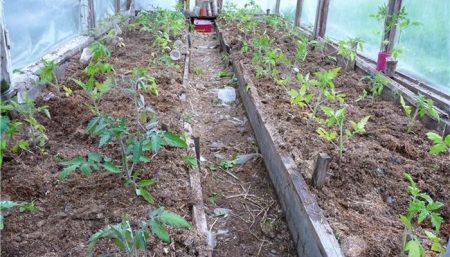
It is believed that such a simple agricultural technique as loosening plays a crucial role in the cultivation of vegetable crops, as it facilitates the soil, breaking up its dense structure; fights weed; contributes to the improvement of water and air permeability of the soil.
In open ground, tomatoes can pollinate themselves. In the greenhouse, it is difficult for the plants themselves to do this. Therefore, you need to regularly shake flowering branches, and then moisten the air with a spray gun. You can also attract insects to the work by opening all the leaves and doors of the greenhouse and placing inside the container with a sweet solution.
Watering
The bushes do not water the first 10 days after planting tomatoes. You should wait for the period of adaptation of plants to new conditions for living. Then, as soon as the tomatoes get stronger, the main stage of cultivation of this culture begins. Watering for tomatoes is very important. Tomatoes like to drink water a lot, but pour them, however, is not worth it. It is noticed that it is better to shorten the tomatoes than to overfill. In addition, excess moisture provokes the development of pathogenic microflora.
The frequency of irrigation of tomatoes in a greenhouse should not exceed twice a week. In moderate summer, once will be enough. The fact that it’s time to water the plants can be judged by the surface of the soil - if it is very dry, then watering is definitely the time.
Pour the tomatoes with warm water under the root. Leaves and stems should remain dry so as not to cause disaster in the form of any disease.
Formation
Big Pink McClintock bushes undergo mandatory molding. It is best to plant the plants in two stems. But many gardeners successfully cultivate these tomatoes in one or three stems. For the correct formation of the bush, all additional shoots (stepsons) that grow from the axils of the leaves are cut off, leaving only one or two (depending on how many trunks it is planned to conduct the bush). The necessary stepsons are left under the first and second flower brush.
Since the plant does not limit its growth throughout life, the height of the bush can reach two or more meters. Because of this, the fruits can ripen longer on the branches, and the last crop is most often removed from the bush even at the stage of milk ripeness. Therefore, it is recommended, 40-50 days before the last harvest (in mid-August), to pinch the top and all the main shoots. This will help redistribute the strength of the plant to the ripening of the fruit, and not to the growth of the green part of the bush.
It should be understood that tomato fruits do not withstand frost. Even if they were taken off “brown”, but they managed to spend some time in a very cold weather, they quickly decay, never having time to ripen on the windowsill.
To ensure the large-fruited tomato, you must also adjust their number. Tall tomato varieties are mainly grown for the sake of giant tomatoes. Therefore, excess inflorescences and ovaries must be removed, leaving two or three buds on each branch.Yes, so the number of fruits will decrease, but the formed tomatoes will be very large, bulk and sweet.
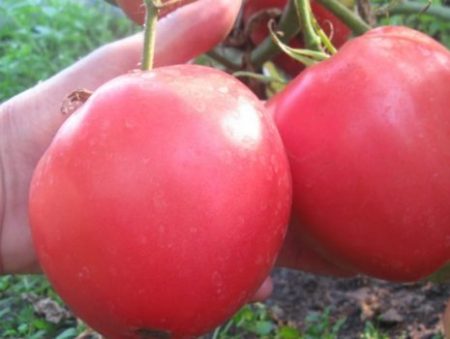
In addition to flowers, extra flower brushes are also removed. Leave only the strongest and most powerful - they will give rise to huge specimens.
It often happens that on the bushes before flowering large double and very beautiful flowers are formed. It is not good. The appearance of such flowers suggests that the plant is “fattening,” that is, pathological processes occur in it. From such flowers in the future, ugly nondescript and tasteless fruits are formed. Therefore, it is recommended to immediately pick off the flowers so as not to waste the energy of the plant on their maintenance.
Top dressing
For the entire period of growing tall tomatoes, it is recommended to carry out at least three top dressings. For the first time, fertilizers are applied under tomatoes 10-12 days after planting on the garden bed. For this, a bird solution or mullein is taken. You can use ready-made fertilizers, such as Gumisol, Veromistin, Rost-concentrate. Fertilizers are laid out in a thick layer (5 centimeters) right under the bushes, and watered abundantly.
To fertilizer remained in the ground as long as possible, its surface must be mulched. As mulch, you can use mowed grass, straw, sawdust. But pine needles are considered the best material for mulch.
The second feeding is carried out 14-16 days after the first, at the time of intensive flowering. This time, organics are also used with the addition of ready-made products ("Solution" or "Kemira station wagon"), 3 grams of manganese, copper sulfate (dissolved in water). Under each bush, two liters of fertilizing is applied.
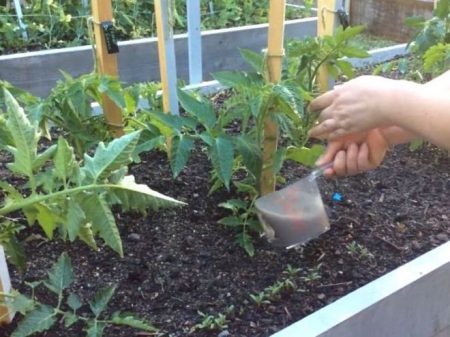
The third recharge is necessary for bushes during fruiting. The composition of this top dressing is the same as in the second, but the concentration of the components increases one and a half times.
Reviews
Catherine
Good large-fruited variety. Raised in a greenhouse. The height of the bushes is 180 centimeters. It led into two trunks. Planted only five bushes, but the harvest pleased. Each bush gave 3-4 kilograms. The fruits are very large, fleshy, not watery, so that they keep the shape well when sliced. During heat treatment, the taste and aroma are not lost. The plants did not hurt anything. It’s easy to take care of tomatoes, no additional tricks were needed. Although I use a lot of fertilizers, everyone likes to eat tomatoes.
Gregory
For a couple of years, I planted "Big Pink McClintock" tomatoes in my garden. The variety is solid, productive and most importantly gives very large tasty tomatoes. Variety of medium ripening. In July, we already eat tomatoes. Bushes grow powerful, big-shouldered, garter must be done constantly. Especially during fruiting, the branches are heavily loaded with heavy fruits and everything immediately breaks, dries. Caution you need to make watering. These tomatoes are undemanding to water, so often you should not water it. It is better to let the earth in a dried state be, otherwise it will not be long before the illness. Bushes bear fruit, as he said from July to the end of September. Tomatoes of this variety we all eat fresh. For conservation I use other varieties.
Victoria
Last year, I cultivated tomatoes of this variety. I liked the grade. Seedlings grew well, there were no problems. Planted in a greenhouse in mid-May. The summer was cool, so the greenhouse had a very comfortable temperature. Maybe that's why the bushes are very well grown, knitted perfectly. Each bush gave 7-9 tomatoes. Each fruit weighing from 300 grams was. Tomatoes are rounded in size, not too even, but not clumsy. It tastes very good, fleshy. The inside is loose, balanced.For the preparation of juices, these tomatoes are very good. Well, we cut them into salads and added them to various dishes. This season also plant this variety. I can’t wait for good results and very tasty sweet tomatoes.




 Low-growing tomatoes, without pinching: 5 of the most delicious varieties
Low-growing tomatoes, without pinching: 5 of the most delicious varieties Why tomato seedlings grow poorly
Why tomato seedlings grow poorly We grow a tomato in a shell
We grow a tomato in a shell Growing tomatoes without watering according to the method of Kazarin
Growing tomatoes without watering according to the method of Kazarin